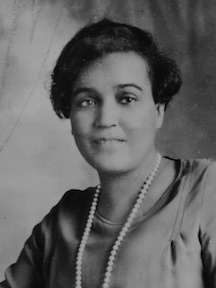By Jacob Sandstrom
Jessie Redmon Fauset, born in 1882 in Camden County, New Jersey, played a crucial yet often unrecognized role in American history as a poet, essayist, and editor. Biographical accounts describe her childhood—growing up as the daughter of a Presbyterian minister in Philadelphia—as formative to her writing and later life. She was to be among the first African Americans elected to Phi Beta Kappa and an important figure of the Harlem Renaissance.
After a remarkable record at the Philadelphia High School for Girls, a young, ambitious Jessie Fauset set her aim on higher education. Among the first African-American females to graduate from Cornell University, Fauset lived at the historic Sage College for Women while studying classical languages. In 1905, she became first African-American woman elected to the Theta of New York Chapter of Phi Beta Kappa. Despite common belief, Fauset was not the first African-American woman ever elected to the Phi Beta Kappa Society, but was a pioneer in her own right.
Leaving Cornell, Fauset became a school teacher, and later, the literary editor of The Crisis, the official magazine of the National Association for the Advancement of Colored People. It was during this time that Fauset made significant contributions to literary history. Aside from her own work, Fauset was responsible for introducing and guiding prominent African-American writers, including Langston Hughes, among many others.
While she was an ascendant voice during the in the 1920s, Fauset was nearly forgotten by the time of her passing in 1961. According to a recent article in The New Yorker, “though [Jessie Redmon Fauset] helped to user in a crucial period of artistic flourishing, and was herself a vital participant in that flourishing, she was not destined to get much credit for it.” This reality is often attributed to the fact that Fauset was a woman, and that her work focused on domestic issues. Further, leaving the NAACP on “bad terms” amid widening divisions with W.E.B. Du Bois left the latter part of Fauset’s professional life largely overlooked.
Speculation on her almost forgotten career aside, it remains that Fauset was an influential “literary midwife,” even if she was overshadowed by her contemporaries. Fauset wrote four novels: There is Confusion (1924), Plum Bun (1929), The Chinaberry Tree (1931), and Comedy: American Style (1933). Throughout, Fauset weaved personal perspectives into the narratives of fictional characters, looking at issues of gender, race, and class as she had experienced as a member of the African-American intelligentsia.
Fauset’s trenchant essays and articles gave insights on the conditions of the era, while her poems evidenced the emotional realities that gave rise to the movement itself. Published in The Book of American Negro Poetry in 1922, “Dead Fires” provides a poignant vignette:
If this is peace, this dead and leaden thing,
Then better far the hateful fret, the sting.
Better the wound forever seeking balm
Than this gray calm!
Is this pain’s surcease? Better far the ache,
The long-drawn dreary day, the night’s white wake,
Better the choking sigh, the sobbing breath
Than passion’s death!
In eight lines, Fauset captures the spirit of the Harlem Renaissance. To strive for a better condition by enduring “the sting” rather than settling for the “gray calm” of the status quo was the movement’s raison d’être. Through cultural, artistic, and social change, the Harlem Renaissance represented major advancement, laying the foundation for progress in the following decades. In remembering the importance of the 1920s as a period of growth for mainstream African-American cultural expression, it is important to recognize the role of a forgotten visionary and key player: Jessie Redmon Fauset.
Jacob Sandstrom is a junior at Case Western Reserve University majoring in Political Science. Case Western Reserve University is home to the Alpha of Ohio Chapter of Phi Beta Kappa.




